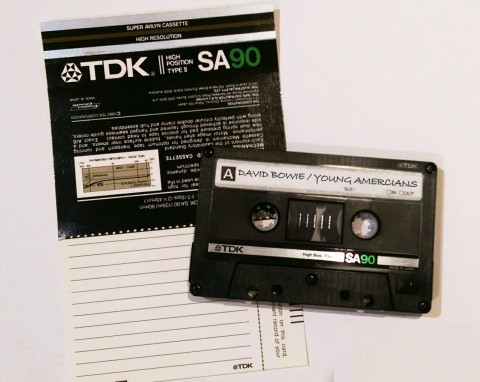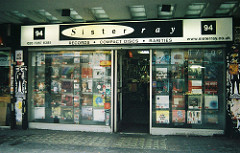Saturday Deluxe Special / A Life Listening to David Bowie: part 2

In the second of a special three-part feature, SDE Editor Paul Sinclair, reflects back to his earliest memories of hearing, buying and listening to the music of David Bowie. If you haven’t read part one, we suggest you start there.
It is 1988 and I am spending much of time time immersed in some of the best music ever released – specifically, Davie Bowie’s output in the 1970s. If you’ve read part one of this, you’ll know I had 12 albums taped, one either side of an SA90, and we’re up to week three in my journey, would have meant listening to Aladdin Sane and Diamond Dogs every day which a full and frank discussion at the weekend with my friend Aubrey (who also had to endure a tedious commute to work every day).
I had, and still have, mixed feelings about Aladdin Sane. By any normal standards it’s a fine record but it’s rather pick ‘n’ mix in terms of style and production and is perhaps slightly rock-n-roll-by-numbers in places – Watch That Man, and the Stones cover Let’s Spend The Night Together come to mind. Also, that annoying low-in-the-mix vocal on the former (only the album opener!) still irritates nearly 30 years on. I never properly dialed into Cracked Actor either, until a few years later when I heard the far better David Live version but I have always loved Prettiest Star, completely unaware at that time that this was a re-recording of an old single (in retrospect it does sound a bit more ‘naive’ and charming then the other material. However THE track on this album that captivated me was the title track. That lazy soft drum sound, the tone in Bowie’s voice and of course Mike Garson’s incredible piano. Amazing.
Crucially, what I couldn’t do with Aladdin Sane was properly lose myself in a world that has a consistent mood and tone. Enter the noir-ish ‘post-apocalyptic’ Diamond Dogs. Bowie had recorded covers album Pin Ups in between these two albums of course, but a) it’s a covers album, b) I didn’t know half the songs he was covering anyway (I was 18 in ’88), and most importantly c) I hadn’t taped it off of school friend Paul Fraser so it was ‘out of scope’ (as project managers like to say) in this Bowie-fest.
I had read (and loved) 1984 and as many of you will know David’s original plan was to put on some kind of theatrical production of George Orwell’s novel, only to be refused permission by his estate. No matter, many 1984-themed songs made it onto Diamond Dogs including We Are The Dead, Rock ‘N’ Roll With Me, 1984 and Big Brother and they do have a pleasing consistency and theatricality to them. In fact all these tracks are on side two of the record, which finishes with the brilliantly titled Chant of the Ever Circling Skeletal Family. I’d go as far to say that side two of Diamond Dogs is up there with any ‘side’ of any album Bowie produced in his career. And when you consider that the real album highlight – the stunning suite of Sweet Thing / Candidate / Sweet Thing (reprise) – is on side one, that illustrates how good this album really is. In fact call me a crazy mother-lover, but I’ve always thought that the inclusion of Rebel Rebel spoils Diamond Dogs. A brilliant, perky pop song about getting dressed up and going out on a Saturday night is the perfect seven-inch single, but sticks out like a sore thumb on this long-player.
Anyhow, six albums in and Diamond Dogs was/is the clear ‘winner’ on my third TDK SA90 and I’ve not changed this position in the last 25 years. The album joins Space Oddity/David Bowie and Hunky Dory in the winners’ enclosure.
Remember, when I was listening to this music I wasn’t looking a glorious high-resolution artwork, or detailed credits with references to musicians, I was looking at some handwritten scrawl which listed the track names and the album title and that was it. Some of you may be aware that the inlay card for a TDK SA90 was rather optimistic when it came to the space available to write the title of the track. The Jean Genie wasn’t a problem, neither was Rebel Rebel, but try writing The Chant of the Ever Circling Skeletal Family in a horizontal space of little over an inch. Things got messy. You’d spend ages with your ‘best pen’ (geek alert – I tried to use the same pen for all tapes) and write s-l-o-w-l-y and carefully. These things didn’t come with spares, so if you cocked up, you’d have to live with it. The rookie’s error was to slide the inlay into the plastic case without waiting for the ink to dry – cue smudges and blotches – NO!!!

The TDK SA90 – My format of choice for home taping
The reason for mentioning this, is that the next Bowie album for a teenage Paul Sinclair was really just another list of songs and a title. The internet hadn’t been invented so, while I may have had little bits of background knowledge, there wasn’t much opportunity to find out what was going on in Bowie’s world in 1975. Well there was, and that was to listen to the album!
It goes without saying that Young Americans was a very different record to its predecessor, but like Diamond Dogs, it was very much a cohesive album. The title track just sounded SO different, but brilliant. Bowie’s stream-of-consciousness lyric is genius, with some brilliant phrases like “misses a step and cuts his hand”. The ‘plastic soul’ as Bowie self-deprecatingly described it was amazing. I remember thinking at the time that I couldn’t really hear the joins, I could see the whole picture but not the edges of the puzzle pieces that make up that picture. What I mean by that is with good old rock ‘n’ roll it was normally easy to decipher guitar, bass, drums, etc. but Young Americans, the album, was this fusion of sounds with weird squawks and flanging and god-knows-what that was just thrilling and mysterious.
Young Americans’ side one; which consists of the title track, Win, Fascination and Right mirrors the strength of Diamond Dogs side two. It’s 20 minutes of bliss. Bowie slightly corrupted the original vision by including Fame and the Across The Universe cover, and dropping Who Can I Be Now? and It’s Gonna Be Me, although it was probably a good decision since Fame reached number one in the USA and helped make the album very commercial successful in America.
Young Americans was on side one of my fourth SA90, while 1976’s Station to Station was on side two. The latter has a nod to the former with Golden Years and a gives a hint to Bowie’s future direction and the so-called ‘Berlin Trilogy’ with the title track, which has Krautrock influences. The album doesn’t really put a foot wrong with the ten-minute tour-de-force that is the title track (“it’s not the side effects of the cocaine, I’m thinking that it must be love”), the funk-rock workout of Stay and the truly affecting Word On A Wing.
David Bowie performs Stay on the Dinah Shore show in 1976
Obviously Bowie had a new ‘character’ with The Thin White Duke, but I wasn’t thinking much about that when I listened to Station To Station. What I was thinking was how can one man write so many good songs that don’t do what most artists do which is to plough the same styles and influences exhibited on previous albums? Station To Station is nothing like Young Americans but is just as good. In fact this is the first SA90 with two Bowie albums where it’s very hard to call a ‘winner’. It’s probably a dead heat, although if you were going to put a gun to my head and force me to make a decision, I’d probably give Young Americans the edge – just.
I’m going to pause for a moment here and skip forward a year or two, before carrying on with this journey through 1970s Bowie, because although in the end I did buy some pre-recorded tapes of some of the albums (not exactly known for their high fidelity) the very late eighties was a great time to become very interested in David’s work because Rykodisc in America were about to launch a massive reissue campaign where his RCA output would be remastered with bonus tracks and reissued on CD. So I would effectively get the opportunity to work through the albums all over again! But before that there was the small matter of Tin Machine!
People forget that first Tin Machine album was actually reasonably well received (4 stars in Q Magazine, for example) although – at odds with what normally happens – its reputation seems to have sunk over the years. I don’t care about that. People who don’t like it are “just a bunch of assholes with buttholes for their brains” (note: that’s a jokey reference to a line from Crack City – perhaps not David’s finest lyric). Anyway… I had tried to enjoy Never Let Me Down, I’d then discovered what a genius David Bowie really was by absorbing in detail, his entire output from the 1970s, and I was wondering if that guy was coming back. Okay, I’m not claiming Tin Machine is on a par with anything in the 1970s – it’s not – but using the Sales brothers for the rhythm section (they played on Iggy Pop’s Lust For Life) gave the project a few strands of 1970s DNA and the sheer gusto of it blew away the cobwebs of mid-to-late eighties ennui (ever heard anyone actually say that word? – me neither). With with songs like Heaven’s In Here, Tin Machine, Under The God he reminded listeners that he could ROCK. Bowie would later years revisit I Can’t Read, such was his regard for that track. Even if Tin Machine wasn’t your bag, Bowie’s conviction had returned. Perhaps for the first time since 1983’s Let’s Dance it sounded like an album he believed in. That was significant.
A second Tin Machine album was actually recorded before Bowie headed out on his 1990 Sound + Vision tour but was held back until its September 1991 release. Tin Machine II was less ‘pure’ than the first album. It was a bit more melodic, had a slightly more nuanced production and felt more like some kind of Bowie-Tin Machine hybrid, with an off-kilter quirkiness apparent in songs like Goodbye Mr Ed, Betty Wrong and the lead single You Belong In Rock ‘n’ Roll (I still have my now rusting CD single of the latter in a round tin box). I really should have seen Tin Machine live and can offer no explanation as to why I didn’t, but it wouldn’t be long before I would see him on stage for the first time in 1990 as he kicked off his Sound + Vision tour.
Tin Machine perform You Belong In Rock ‘N’ Roll on UK TV’s Paramount City
Before that, there was the small matter of Ryko’s Sound + Vision reissue campaign. I remember clearly, the Virgin Megastore at the Tottenham Court Road end of London’s Oxford Street literally piling up Ryko’s Sound + Vision box set on the floor and the towers of newly remastered Bowie rarities rising to five or six feet high. Don’t forget, this box wasn’t released officially in the UK at all. As if it needed to be any more exciting, it was an ‘import’, to add to the desirability (it eventually came out in Britain in inferior packaging in 2003 and then again in 2014).
Another opportunity here for me to pat myself on the back (I did that a lot) because having spent all that time on the train listening to ‘RCA’ Bowie on those SA90s, I could really appreciate the many rarities dotted around the four discs (the box contained 47 audio tracks across three CDs and a 4-track CD-Video disc). There’s nothing worse than being presented with some rare single version of a track when you don’t know the ‘normal’ album version. So I really consumed the music voraciously. 1984 from Diamond Dogs was fused here with a track called Dodo, a great Young Americans outtake After Today featured on CD 2 (this has still not surfaced anywhere else) and Bowie covered Springsteen’s It’s Hard To Be A Saint In The City (see Bruce’s tribute to Bowie here).
I should point out that I bought my first CD player in autumn 1989, so this was a double whammy of hearing remastered and rare Bowie for the first time and enjoying the clarity of CD sound quality. Point of note here, no music fans ever talked about ‘remastering’ in 1989. I had no idea what it was until I poured over the sleeve notes of Sound + Vision and read about the mysterious sounding Dr. Toby Mountain. I think I must have had visions of a man in a white coat, perhaps in the rarified air of a lab in Switzerland, deconstructing and tinkering with David’s music.

The next few years (1990-1992) were some of the most enjoyable of my life when it comes to buying David Bowie albums. Ryko spent over two years reissuing the RCA back catalogue and even though EMI released them in Europe, I always wanted the Ryko versions, which just seemed… cooler. This was actually rather tricky since while the box set was freely available in the UK at the end of 1989, EMI (perhaps not unreasonably) enforced an embargo to stop the individual albums being imported to protect their marketplace. Thankfully, even though you would be out of luck in HMV, Virgin Megastore etc. there were independent record shops that would stock them (naughty!). My retailer of choice was Sister Ray in Berwick St., which at that point was still in its old location where the market is and had only been open for a few years (the shop in its current location, closer to Oxford Street, used to be Selectadisc). Every three or four months, a new batch of reissues would appear. I even bought the so-called Berlin Trilogy (with live album Stage) packaged in a special Sound + Vision metal display case, which was big enough to hold all the Sound + Vision reissues (sadly that got lost in a house move).
Most of the reissues had a few bonus tracks but it was the packaging and presentation that was really educational. Even though by today’s standards the eight-panel poster booklet/inserts might seem lightweight, they were so well designed, and always carried any alternate album covers and the lyrics. As I have said, this was a pre-internet era (i.e. I’m old), so even when I’d bought an official cassette of, for example, The Man Who Sold The World, all you got was that black and white front cover of Bowie kicking his legs in the air and the track listing of the album, and maybe a few credits. That was it. It’s no wonder that ‘home taping’ was so popular, when tapes were so dire. It was hard to know or find out much else about the album, so the photos of David from the year the album was issued along with lyrics and those album covers were a big deal. I had no idea, for example, that David Bowie had those long flowing locks and wore the ‘man’s dress’ at this point in time, until I bought the Rykodisc reissue.
As hinted above, I first saw David play live on the Sound + Vision tour in Milton Keynes Bowl in 1990. Of course it was very exciting, although I will admit the whole standing-in-a-field-for-half-a-day, and then being very far away when he eventually came on stage, took the edge of it a bit. That and the fact the band played Adrian Belew’s Pretty Pink Rose (not one of Bowie’s best). I won’t mention the wait for the ‘shuttle bus’ back to the train station, after which we then had to get the train back to London. I have no idea why I didn’t go to the London gigs. That would have been too easy. However the next time I would see him play would be so much better!
The third and final instalment of A Life Listening to David Bowie will be published next week.



By Paul Sinclair
66